Copper Material: A CNC Machining Material
Copper often gets overlooked in the CNC world, but the wrong material can mean higher costs, poor finishes, and failed tolerances. Copper material solves these problems with precision and performance.
Copper is one of the most thermally and electrically conductive metals, making it ideal for CNC machining in critical applications like electronics, automotive, and optics. Let’s explore its properties, benefits, grades, and how it compares with other CNC metals.
What Is Copper?
Copper is a reddish-orange metal recognized for its softness, high conductivity, and corrosion resistance. As a periodic element cu, it sits in Group 11 and is considered a noble metal with low reactivity. Commonly referred to as material cu, it is the base of several important alloys, including bronze and copper and is brass bronze variants.
Its natural light copper color makes it aesthetically pleasing. You might see it in forms like copper pieces, copper plated bowl, or architectural finishes. A copper picture shows its signature tone, which can change slightly with oxidation over time.
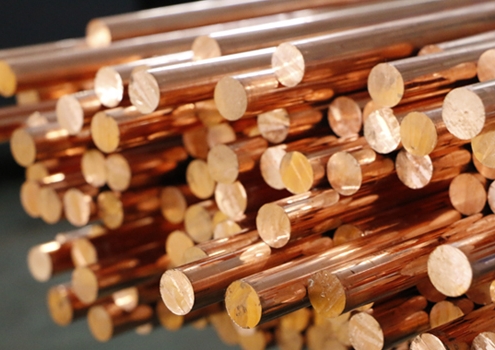
How Is Copper Produced?
Copper production starts with mining ores like chalcopyrite and malachite. These ores are crushed and concentrated through flotation to extract copper-rich material.
The concentrate is then smelted to produce matte copper, which is further refined in a converter to create blister copper with around 98–99% purity.
To reach high copper purity (99.99%), the blister copper undergoes electro-refining, where pure copper pieces are deposited onto cathodes.
The result is high-grade copper material ready for forming into bars, plates, and wires used in CNC machining and industrial applications.
Properties of Copper for CNC Machining
Copper is a standout material for CNC machining, thanks to its exceptional mechanical, thermal, and electrical properties. Its ability to combine precision with functionality makes it suitable for components requiring high performance under thermal or electrical stress. Below is the key properties that make copper ideal for CNC machining:
| Property | Typical Value | Description |
|---|---|---|
| Thermal Conductivity | ~400 W/mK | Exceptional thermal performance, ideal for heat exchangers and thermal management systems. |
| Electrical Conductivity | 100% IACS | Benchmark for electrical efficiency, widely used in electrical and electronic components. |
| Tensile Strength | ~200–400 MPa | Provides a balance of durability and workability for moderate mechanical stress. |
| Density | 8.96 g/cm³ | High density offers stability and vibration resistance in various applications. |
| Corrosion Resistance | Excellent | Resistant to air, water, and certain chemicals, ensuring longevity and reduced maintenance. |
| Machinability | Smooth and Precise Finishes | Enables tight tolerances and high-quality finishes for intricate geometries. |
Copper CNC Machining Processes
Copper machining requires specialized techniques to achieve precision and efficiency due to its unique properties. Below are the key processes commonly used for machining copper in CNC applications:
1. High-Speed Milling
This process is employed for the rapid removal of material and the creation of complex geometries. High-speed milling ensures precision and efficiency, making it suitable for intricate designs.
2. Micro-Drilling
Micro-drilling is used to machine small-diameter holes with exceptional accuracy. It is particularly useful in applications requiring fine details and tight tolerances.
3. Electrical Discharge Machining (EDM)
EDM is ideal for creating intricate and detailed features that are challenging to achieve with conventional cutting tools. It works by eroding material using electrical discharges, ensuring precision in complex designs.
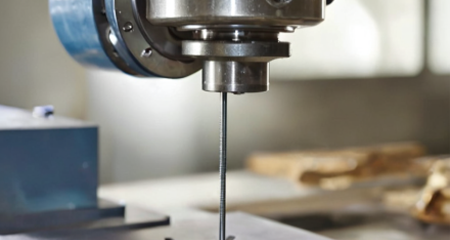
4. Surface Finishing
Surface finishing techniques like brushing and polishing are used to achieve smooth, refined surfaces. These processes enhance the aesthetics and functionality of the machined parts.
Common Grades of Copper for CNC Machining
Different grades of copper are used in CNC machining based on specific application requirements. Each grade offers unique properties that make it suitable for various industries and functions.
| Grade | Description | Key Applications |
|---|---|---|
| C10200 | High-purity copper with low oxygen content, offering excellent strength and precision. | Precision parts requiring high purity. |
| C110 | Known as electrolytic tough pitch (ETP) copper, widely used for its high electrical conductivity. | Electronics, electrical connectors, and busbars. |
| C145 | Free-machining copper with added tellurium for improved chip formation and machinability. | Components requiring efficient machining. |
| C182 | High-strength copper alloy commonly used in resistance welding applications due to its durability. | Resistance welding equipment and tooling. |
Pros and Cons of Copper in CNC Machining
Copper is a sought-after material for CNC machining due to its exceptional properties, but it also comes with challenges that require expertise to manage effectively. Below is a detailed breakdown of its advantages and disadvantages:
Advantages
1. Excellent Thermal and Electrical Conductivity
Copper is unmatched in its ability to conduct heat and electricity, making it ideal for applications in electronics, power systems, and thermal management.
2. Smooth Surface Finish
Copper’s inherent properties allow for smooth and precise surface finishes, which are essential in industries like medical and aerospace.
3. High Dimensional Stability
Copper maintains its shape and dimensions under thermal and mechanical stress, ensuring reliability in high-precision applications.
4. Corrosion Resistance
Resistant to environmental factors like air and water, copper components have a long lifespan and reduced maintenance needs.
Disadvantages
1. Tool Wear Can Be High
Copper’s abrasiveness and tendency to adhere to cutting tools can accelerate tool wear, necessitating frequent replacements or specialized tooling.
2. Softer than Many Metals
Copper’s softness requires careful handling to prevent deformation or damage during machining and transportation.
3. Higher Raw Material Cost
Copper is more expensive than alternatives like aluminum or mild steel, which can increase production costs.
Can Copper Be Used in High-Precision CNC Machining?
Copper is highly suitable for high-precision CNC machining due to its excellent dimensional stability and machinability. Its physical properties allow manufacturers to achieve extremely tight tolerances, often as precise as 0.01 mm. This makes copper a preferred material for components where accuracy is critical.
Industries such as optics, semiconductors, and electronics rely on copper parts for their precise and reliable performance. Examples include optical components that require exact alignment, semiconductor bases that need stable thermal and electrical conduction, and connector pins that demand precise dimensions for optimal connectivity.
At VMT, advanced multi-axis CNC machines combined with rigorous quality control enable the production of copper parts with atomic-level accuracy. The polished surface finish rivals that of high-end consumer electronics, ensuring both functionality and aesthetic appeal in the final product.
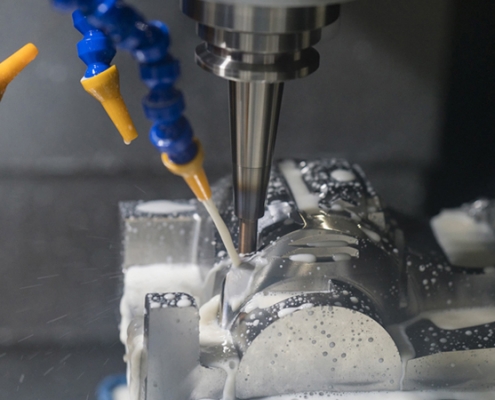
How Does Surface Treatment Enhance Copper CNC Parts?
Surface treatment is essential for maintaining the integrity and appearance of copper parts after machining. These treatments help preserve the material’s purity, preventing oxidation and tarnishing which could degrade performance or appearance over time.
Treatments also significantly extend the service life of copper components, protecting them against corrosion, wear, and environmental damage. This is especially important for parts used in harsh or demanding conditions, ensuring long-term reliability.
VMT offers a variety of surface finish options to meet a variety of application needs, including rust-resistant coatings, nickel plating, and brushed or mirror finishes. These surface finishes help copper parts meet both functional and visual requirements.
Comparison of Copper, Aluminum, and Stainless Steel in CNC Machining
Copper, aluminum, and stainless steel each have distinct properties that affect their performance, cost, and suitability for various CNC machining applications. The following is the key differences and advantages of each material:
| Property | Copper | Aluminum | Stainless Steel |
|---|---|---|---|
| Thermal Conductivity | Very high (~400 W/mK), excellent heat handling | Moderate (~205 W/mK), good for many heat dissipation applications | Low (~16 W/mK), less efficient for heat transfer |
| Electrical Conductivity | Highest (100% IACS), ideal for electrical components | Low, not suitable for high electrical conductivity needs | Very low, not used for electrical purposes |
| Strength | Moderate tensile strength (~200–400 MPa) | Lower tensile strength (~70–700 MPa depending on alloy) | High tensile strength (~500–1000 MPa) |
| Malleability & Machinability | Highly malleable and easy to machine but can be gummy | Easy to machine, lightweight, and versatile | Harder to machine, requires specialized tooling |
| Corrosion Resistance | Good, naturally corrosion-resistant | Moderate, prone to oxidation unless treated | Excellent, very resistant to rust and corrosion |
| Cost | Higher raw material cost | Generally low cost and widely available | Higher cost than aluminum but usually less than copper |
| Appearance | Warm, reddish finish, attractive for decorative parts | Silver-gray, matte to shiny finish | Silver, often polished or chrome-like finish |
| Typical Applications | Electrical connectors, heat exchangers, decorative parts | Aerospace, automotive, lightweight structures | Medical instruments, structural components, food industry |
Applications of Copper CNC Parts
Copper is an incredibly versatile material widely used across various industries due to its excellent thermal and electrical properties, corrosion resistance, and machinability. Its applications span from everyday electronics to high-tech medical and industrial equipment. Here are some of the key areas where copper CNC parts play a crucial role:
1. Electronic Technology
Copper is fundamental in electronics manufacturing, where it is used to produce terminals, connectors, and heat sinks. These components benefit from copper’s superior electrical conductivity, ensuring efficient power transmission and heat dissipation, which are critical for device performance and longevity.
2. Automotive Industry
In the automotive sector, copper parts are essential for fuel injector components and brake systems. Its thermal conductivity helps manage heat generated during operation, while its corrosion resistance ensures durability under harsh conditions. Copper also supports electric vehicle components, contributing to battery and charging system efficiency.
3. Medical Equipment
Copper’s natural antimicrobial properties and excellent conductivity make it ideal for medical applications such as MRI shielding and conductive implants. Precision-machined copper parts help in producing reliable, safe, and effective medical devices, improving patient outcomes and equipment longevity.
4. Industrial Applications
Copper components are widely used in industrial settings for thermal plates, heat exchangers, and other parts requiring efficient heat dissipation. Its ability to withstand high temperatures and resist corrosion makes copper indispensable in manufacturing processes and heavy machinery.
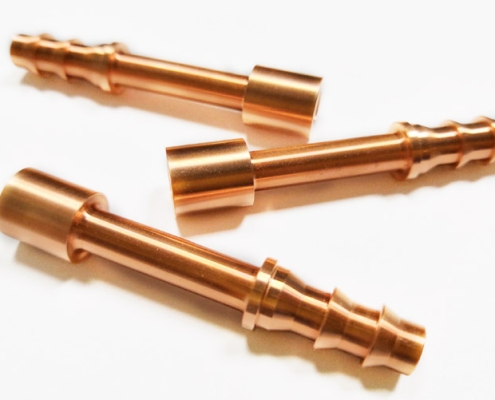
5. Optical Technology
In optics, copper is used to manufacture precision mounts and laser housings. Its stability and machinability allow for the creation of components with tight tolerances, essential for maintaining alignment and performance in sensitive optical systems.
Copper’s broad applicability combined with its unique material properties makes it a preferred choice for CNC-machined parts across multiple high-demand industries.
Why Choose VMT for Your Custom Copper CNC Parts?
VMT has over 15 years of CNC machining experience with more than 100 machines and engineers who have 20 years of expertise. VMT operates under ISO and IATF-certified quality systems to deliver consistent and reliable results and fast delivery within 24 hours. Our team is skilled in machining various copper grades and finishes. We also provide design assistance to improve manufacturability.
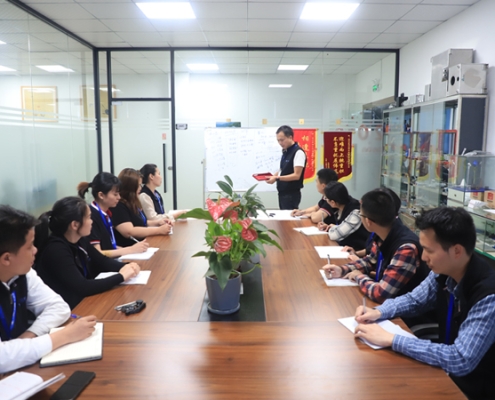
In Conclusion
Copper is a versatile, highly conductive CNC material. VMT ensures precision, fast delivery, and expert craftsmanship, making it ideal for high-quality copper parts across industries.
More Resources: Copper vs Brass: A Guide to the Differences and Distinctions
Copper CNC Machining: Advantages, Disadvantages and Applications
Brass vs Bronze vs Copper: Differences and Distinctions
How Hot Does Copper Have to Melt?
Frequently Asked Questions About Copper
Does Copper Material Rust?
No, copper material does not rust because it doesn’t contain iron. Instead, it develops a green patina called copper oxide over time when exposed to air and moisture. This layer actually protects the metal from further corrosion.
Is Copper a Heavy Metal?
Yes, copper is a heavy metal. It has a high density of about 8.96 g/cm³. While it’s essential in electrical and thermal applications, excessive exposure can be toxic, which is why it’s classified as a heavy metal in environmental contexts.
Can a CNC Machine Cut Copper?
Yes, CNC machines can cut copper material effectively. However, due to its high ductility and thermal conductivity, copper machining requires sharp tools, proper cooling, and optimized feed rates to avoid tool wear and overheating.
What is the Best Copper for CNC Machine?
C110 copper, also known as electrolytic tough pitch (ETP), is widely used for CNC machining because of its excellent conductivity and good machinability. For finer precision, C101 (oxygen-free) copper offers higher purity and better thermal properties.
What is the Difference Between C101 and C110 Copper?
C101 copper is oxygen-free, offering 99.99% copper purity, ideal for high-end electrical and vacuum applications. C110 copper has slightly lower purity (~99.9%) but is more cost-effective and commonly used in machining copper parts like terminals and connectors.



